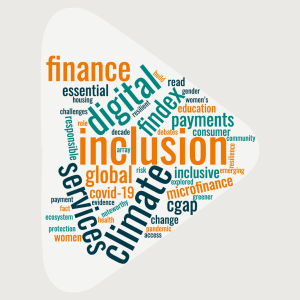As 2022 comes to a close, it’s time for our annual roundup of the year’s most popular blog posts. As always, we hope that you’ve found the CGAP blog to be a useful source of expert commentary on the latest developments in financial inclusion, timely research and data, and new ideas.
Our blog covered a diverse range of topics throughout the year. With the world largely past the worst of the COVID-19 pandemic, focus has shifted to other issues that require our attention – namely, a changing climate that disproportionately impacts those living in poverty. Ahead of World Environment Day 2022, CGAP CEO Sophie Sirtaine discussed why financial inclusion matters in this era of urgent climate change. We also took a look at the opportunities financial services offer platform workers, asked if funders can afford to ignore gender norms in financial inclusion, and dissected the long-standing debate on whether microfinance is a friend or foe to those living in poverty worldwide.
Also in the spotlight this year was the Global Findex 2021, which was released over the summer. The dataset was rich with insights on global account ownership, usage, and financial resilience – particularly as they relate to digital finance – and our bloggers quicky set about analyzing the results. They discussed what the latest findings mean through the lens of consumer protection, how more effort is needed to sustain the financial inclusion trajectory in Sub-Saharan Africa, whether the increase in G2P payments globally is translating to inclusion at scale, and, more broadly, do we have the right indicators to measure success?
Check out our audience’s favorite topics (and more) below.

In her first blog post as CGAP CEO, Sophie Sirtaine proposed a global agenda for financial inclusion that leads to an inclusive, greener, and more resilient world.

World Environment Day 2022, themed “Only One Earth”, reminded us that this planet is humanity’s only home, with finite resources that we must safeguard. In this blog, we looked not only at who pollutes, but who suffers the impact of climate change most.

The latest Global Findex contains a deep array of insights on global account ownership, usage, and financial resilience. Here, we examined two trends particularly worth exploring – the growth in digital payments that took place in the context of the COVID-19 pandemic, and the relationship between digital payment adoption and use of other financial services.

Mobile payments took hold over a decade ago, but Latin America didn’t experience the traction seen elsewhere. Since then, two emerging business models for digital payments in Colombia and Haiti achieved particular success. What did they get right?

Microfinance was once again in the hot seat this year, with two debates fueling a seemingly never-ending cycle of support and criticism for the industry. In this blog, we proposed ways to close knowledge gaps that perpetuate these debates, which are also relevant for the broader financial inclusion community.

With the rapidly changing digital finance market bringing new risks that can only be addressed through a new, holistic approach to consumer protection, this leadership essay argued that it is now time to build a “responsible digital finance ecosystem”.

Believing that financial services can play a role in closing the essential services access gap, CGAP has spent the last decade exploring how financial services can advance access to essential services like education, energy and clean water for the world’s poor. Our findings suggest that financial services are important tools for advancing equitable access to quality essential services like education, housing, and health care.

For International Women’s Day 2022, CGAP identified dozens of consumer risks facing digital financial services users around the world, and emerging evidence suggests women are more at risk than men. In this piece, we highlighted some ways to mitigate these risks for women.

Between the global big techs and the local unicorns, platforms will soon be a major force in financial services if they are not already. Here, we shared the three main sets of challenges platforms pose for regulators.

Teenage men and women in Kenya and South Africa adopt formal savings accounts at similar rates. But when they hit their 20s, men continue to adopt formal services while women begin gravitating toward informal services. Why is that?



